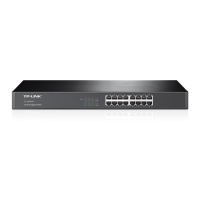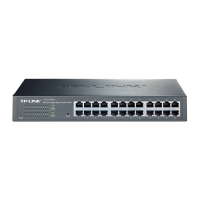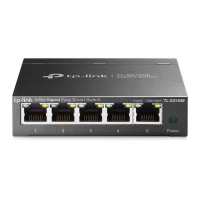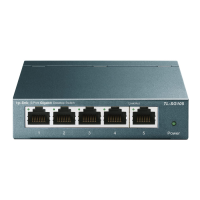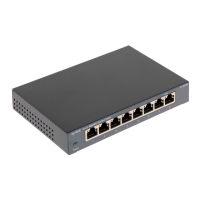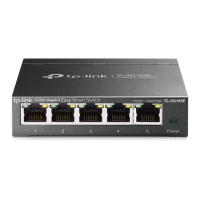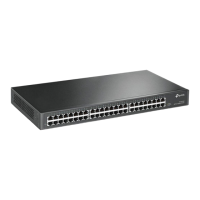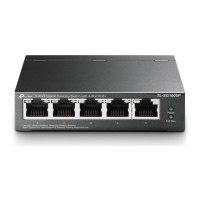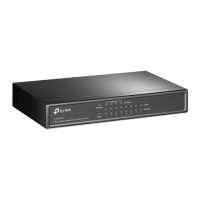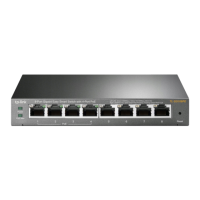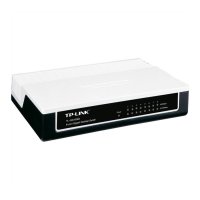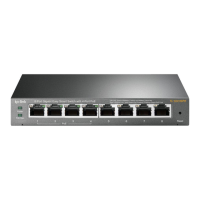Do you have a question about the TP-Link TL-SG1016D and is the answer not in the manual?
Warns that the product is Class A and may cause radio interference in domestic environments.
Details the switch's high-performance, low-cost, and easy-to-use nature for upgrading networks to 1000Mbps.
Lists key technical features including IEEE standards, port capabilities, flow control, and auto-learning.
Explains the front panel of the TL-SG1008, including LED indicators and RJ-45 ports.
Describes the rear panel of the TL-SG1008, featuring the AC power socket and grounding terminal.
Covers essential safety requirements and location guidelines before installing the network switch.
Step-by-step guide for placing the switch on a flat surface using supplied rubber feet.
Instructions for securing the switch into an EIA standard 19-inch rack using brackets.
Explains how to ground the switch for lightning protection via a grounding bar or power supply.
Describes the procedure for powering on the switch and the expected LED indicator behavior.
Troubleshooting steps if the switch's power LED fails to illuminate, checking power source and connections.
Steps to resolve issues where the Link/Act LED is off, checking cable connections, device status, and cable length.
Warns that the product is Class A and may cause radio interference in domestic environments.
Details the switch's high-performance, low-cost, and easy-to-use nature for upgrading networks to 1000Mbps.
Lists key technical features including IEEE standards, port capabilities, flow control, and auto-learning.
Explains the front panel of the TL-SG1008, including LED indicators and RJ-45 ports.
Describes the rear panel of the TL-SG1008, featuring the AC power socket and grounding terminal.
Covers essential safety requirements and location guidelines before installing the network switch.
Step-by-step guide for placing the switch on a flat surface using supplied rubber feet.
Instructions for securing the switch into an EIA standard 19-inch rack using brackets.
Explains how to ground the switch for lightning protection via a grounding bar or power supply.
Describes the procedure for powering on the switch and the expected LED indicator behavior.
Troubleshooting steps if the switch's power LED fails to illuminate, checking power source and connections.
Steps to resolve issues where the Link/Act LED is off, checking cable connections, device status, and cable length.
| 10G support | No |
|---|---|
| Full duplex | Yes |
| Networking standards | IEEE 802.3ab, IEEE 802.3u, IEEE 802.3x |
| Cable types supported | Cat3, Cat4, Cat5, Cat5e |
| Copper ethernet cabling technology | 10BASE-T, 100BASE-TX, 1000BASE-TX, 1000BASE-T |
| Jumbo frames | 10000 |
| Forwarding rate | 23.8 Mpps |
| MAC address table | 8000 entries |
| Switch type | Unmanaged |
| Supported network protocols | CSMA/CD, TCP/IP |
| Power connector | AC-in jack |
| Installed SFP modules quantity | 0 |
| Basic switching RJ-45 Ethernet ports type | Gigabit Ethernet (10/100/1000) |
| Basic switching RJ-45 Ethernet ports quantity | 16 |
| Product color | Black |
| Power source | AC |
| AC input voltage | 100 - 240 V |
| AC input frequency | 50/60 Hz |
| Power consumption (max) | 9.26 W |
| Heat dissipation | 31.6 BTU/h |
| Storage temperature (T-T) | -40 - 70 °C |
| Operating temperature (T-T) | 0 - 40 °C |
| Storage relative humidity (H-H) | 5 - 90 % |
| Operating relative humidity (H-H) | 10 - 90 % |
| Package type | Box |
| Package depth | 400 mm |
| Package width | 250 mm |
| Package height | 80 mm |
| Package weight | 1850 g |
| Harmonized System (HS) code | 85176990 |
| Maximum cable length | 100 m |
| Compatible operating systems | Microsoft Windows 2000/XP/2003/Vista/2008/7/2012/8/10 MacOS NetWare UNIX Linux |
| Sustainability certificates | CE, Federal Communications Commission (FCC), RoHS |
| Depth | 180 mm |
|---|---|
| Width | 294 mm |
| Height | 44 mm |
